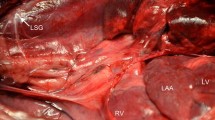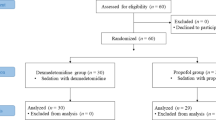Abstract
Purpose
To clarify the sudden onset of profound bradycardia or hypotension during spinal anesthesia, we stimulated vagal nerves (VN) or vagosympathetic trunks (VST) to examine the effects on the autonomic nervous system during spinal anesthesia with different degrees of cardiac sympathetic nerve block.
Methods
Cats were anesthetized and mechanically ventilated. The left stellate ganglion was exposed to record cardiac sympathetic nerve activity (CSNA). Systolic and diastolic blood pressures (BP), heart rate (HR), and CSNA were measured before and after intrathecal injections of 0.2, 0.5 and 1.0 ml of 1% lidocaine. After each intrathecal injection of lidocaine, bilateral VST (n=5, group A) or VN (n=5, group B) were stimulated and measurements were repeated.
]Results
After 1.0 ml intrathecal injection of 1% lidocaine, CSNA was blocked completely, and BP and HR were decreased. In group A, BP were unchanged following VST stimulation while in group B, BP decreased approximately 30% by VN stimulation from the pre-stimulation levels after 0.2, 0.5, and 1.0 ml injection of 1% lidocaine, respectively. HR decreased further, approximately 35% in group A and 50% in group B, by each stimulation from the prestimulation levels after 0.2, 0.5, and 1.0 ml injection of 1% lidocaine.
Conclusion
These results suggest that hypotension and bradycardia during a high level of spinal anesthesia are due to the block of CSNA, and vagal reflex may produce profound hypotension and bradycardia especially in high spinal anesthesia.
Similar content being viewed by others
References
Caplan RA, Ward RJ, Posner K, Cheney FW (1988) Unexpected cardiac arrest during spinal anesthesia: a closed claims analysis of predisposing factors. Anesthesiology 68:5–11
Wetstone DL, Wong KC (1974) Sinus bradycardia and asystole during spinal anesthesia. Anesthesiology 41:87–89
Mackey DC, Carpenter RL, Thompson GE, Brown DL, Bodily MN (1989) Bradycardia and asystole during spinal anesthesia: a report of three cases without morbidity. Anesthesiology 70:866–868
O'Rourke GW, Greene NM (1970) Autonomic blockade and the resting heart rate in man. Am Heart J 80:469–474
Brown DL (1994) Spinal, epidural and caudal anesthesia. In: Miller RD (ed) Anesthesia. Churchill Livingstone, New York, pp 1505–1533
Thurston CL, Randich A (1992) Effects of vagal afferent stimulation on ON and OFF cells in the rostroventral medulla: relationships to nociception and arterial blood pressure. J Neurophysiol 67:180–196
Hochstenbach SL, Ciriello J (1994) Cardiovascular effects of NaCl microinjections into the nucleus of the solitary tract. Brain Res 644:233–242
Schwartz PJ, Pagani M, Lombardi, F, Malliani A, Brown AM (1973) A cardiocardiac sympathovagal reflex in the cat. Circ Res 32:215–220
Downing SE, Siegel JH (1963) Baroreceptor and chemoreceptor influences on sympathetic discharge to the heart. Am J Physiol 204:471–479
Greene NM (1958) The area of differential block during spinal anesthesia with hyperbaric tetracaine. Anesthesiology 19:45–50
Chamberlain DP, Chamberlain BDL (1986) Changes in the skin temperature of the trunk and their relationship to sympathetic blockade during spinal anesthesia. Anesthesiology 65:139–143
Malmqvist LA, Bengtsson M, Bjornsson G, Jorfeldt L, Lofstrom JB (1987) Sympathetic activity and haemodynamic variables during spinal analgesia in man. Acta Anaesth Scand 31:467–473
Cook PR, Malmqvist LA, Bengtsson M, Tryggvason B, Lofstrom JB (1990) Vagal and sympathetic activity during spinal analgesia. Acta Anaesth Scand 34:271–275
Glick G, Braunwald E (1965) Relative roles of the sympathetic and parasympathetic nervous systems in the reflex control of heart rate. Circ Res 16:363–375
Levy MN, Zieske H (1969) Autonomic control of cardiac pacemaker activity and atrioventricular transmission. J Appl Physiol 27:465–470
Vardhan A, Kachroo A, Sapru H N (1993) Excitatory amino acid receptors in the nucleus tractus solitarius mediate the responses to the stimulation of carotid-pulmonary vagal afferent C fiber endings. Brain Res 618:23–31
Shorten G, Furness G (1990) Diabetes and hypotension. Anaesthesia 45:169
McCrae AF, Wildsmith JAW (1993) Prevention and treatment of hypotension during central neural block. Br J Anaesth 70:672–680
Author information
Authors and Affiliations
About this article
Cite this article
Kasaba, T., Taniguchi, M. & Takasaki, M. Effects of vagal nerves or vagosympathetic trunks stimulation on the hemodynamics during spinal anesthesia in cats. J Anesth 11, 208–212 (1997). https://doi.org/10.1007/BF02480039
Received:
Accepted:
Issue Date:
DOI: https://doi.org/10.1007/BF02480039




